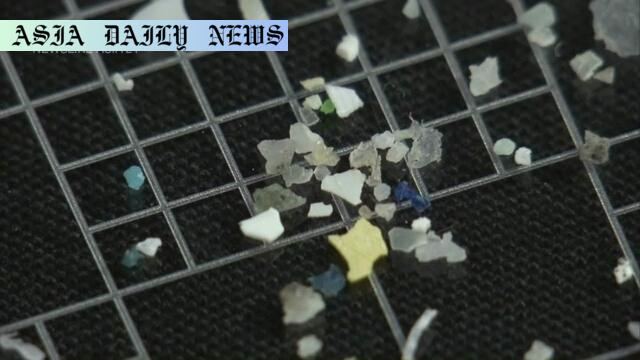Microplastics are spreading throughout oceans from surface levels to several-thousand-meter depths, raising ecosystem concerns.
- Microplastics are polluting waters from surface to deep levels.
- Particles under 0.1 mm spread evenly and persist.
- Ecosystem disturbances raised by ingestion by marine creatures.
- Efforts needed for unified global research and cleanup strategies.

Understanding Microplastics and Their Spread
Microplastics are minute plastic particles that measure 5 millimeters or smaller, primarily resulting from the disintegration of larger plastic debris. While seemingly minor, their size enhances their pervasiveness, allowing them to infiltrate vast sections of our oceans. According to an international research team led by the Japan Agency for Marine-Earth Science and Technology (JAMSTEC), microplastics have been found at nearly every depth of the ocean, from the surface to several thousand meters below. Using data collected from 1,885 sampling stations over a decade, the researchers highlighted the alarming distribution and longevity of these particles in aquatic ecosystems.
One concerning discovery from the study is that microplastic particles under 0.1 millimeters are particularly pervasive. Unlike larger particles, these smaller pieces can diffuse more evenly between the ocean’s surface and its depths. This dispersed distribution prolongs their residence time in marine environments, indirectly impacting ecosystems over extended periods. The researchers emphasize that this persistence gives microplastics ample time to integrate into marine food chains, posing significant risks to aquatic fauna and, ultimately, to human health through seafood consumption.
Impact on Marine Ecosystems
Microplastics are not merely passive pollutants; their presence directly impacts marine ecosystems. Marine creatures, ranging from tiny plankton to large fish species, often mistake these particles for food. Once ingested, microplastics can block digestive tracts, inhibit nutrient absorption, and introduce harmful chemical compounds into the organisms. Over time, bioaccumulation—the gradual buildup of toxins in creature bodies—can cascade through the food web, amplifying the pollutants’ effects.
The research team warns that these disruptions could have long-lasting ramifications. For instance, depleted fish populations due to ingestion-related mortality might destabilize marine biodiversity. Additionally, the redistribution of microplastics by ocean currents means that even pristine remote environments are not immune to their effects. Islands, seabeds, and deep-sea ecosystems—all critical to global ecological balance—face rising threats.
The Call for Unified Research
While the findings underscore the widespread nature of oceanic microplastic pollution, they also shed light on the fragmentation of research methodologies. Shiye Zhao, an associate researcher at JAMSTEC, expressed hope for greater international collaboration. He believes standardizing data collection would greatly enhance the efficacy of future investigations into microplastics’ behavior and distribution.
Such efforts are critical. As the study shows, current methodologies yield robust but fragmented insights. A unified approach would allow scientists to monitor trends, predict impact trajectories, and design comprehensive intervention measures. Moreover, intergovernmental cooperation can promote consensus-driven policies aimed at curbing plastic waste and improving marine health at an international level.
Solutions and Next Steps
Addressing microplastic pollution requires both preventive and remedial measures. Preventive strategies include reducing plastic production, enhancing recycling infrastructure, and educating communities about sustainable consumption. Government policies and corporate accountability frameworks can further deter plastic waste dumping into oceans.
On the remedial front, scientists are exploring innovative technologies to extract microplastics from water. Initiatives like ocean-cleaning drones, magnetic filtration systems, and bioengineering could play key roles in restoration efforts. However, these solutions demand significant financial and technological investments, underscoring the importance of global partnerships.
The study’s revelations serve as a wake-up call. Without immediate collective action, microplastics will continue to jeopardize marine ecosystems, fisheries, and food security systems worldwide. Organizing educational outreach, research innovations, and legislative interventions must be prioritized to curb this invisible yet damaging crisis.



Commentary
Microplastics: A Silent but Deadly Threat
The report on microplastics infiltrating oceans at all depths is both alarming and thought-provoking. While we have long known about surface-level plastic pollution, the discovery of microplastics evenly distributed across several-thousand-meter depths brings a new dimension to the problem. These particles, often invisible to the naked eye, have the capacity to silently and systematically harm marine life. From plankton to apex predators, microplastics make their way across food webs, raising questions about their implications for human health as well.
What strikes me most is the time-sensitive nature of this issue. Microplastics under 0.1 millimeters take far longer to sink, meaning their influence persists over decades, possibly even centuries. This extended residence time highlights the urgent need for both immediate mitigation measures and long-term global commitment to reducing plastic waste. The ocean, often seen as an infinite resource, is turning into a repository for human negligence. This shift in our perception of marine ecosystems must be addressed head-on.
A Call for Unified Efforts
Another aspect of the study that resonates deeply is the fragmentation of research methods. The assertion by Shiye Zhao that international collaboration with standardized data gathering is needed makes perfect sense. A problem as far-reaching as microplastic pollution cannot be addressed by individual nations or isolated research efforts. Global partnerships must be forged to create a unified front against pollution. Furthermore, public awareness campaigns can play a pivotal role in driving grassroots action. Educating people about the lifecycle of plastics and their eventual journey to oceans can encourage behavioral change.
In conclusion, the report is a stark reminder of humanity’s growing imprint on our planet. Solving the microplastic crisis is not just about cleaning our oceans—it’s about reevaluating our entire approach to consumption and waste. The path forward demands innovation, unity, and, most importantly, the will to act. Every individual, organization, and government must play a role in restoring our oceans for future generations.